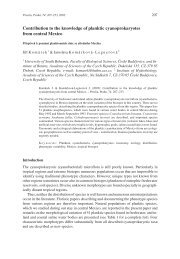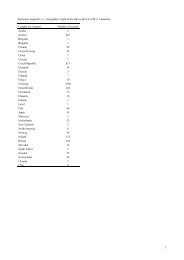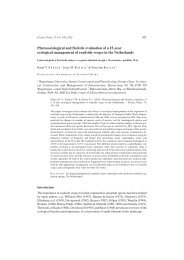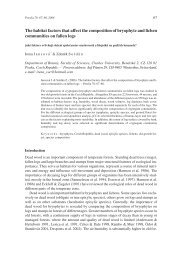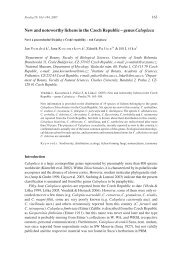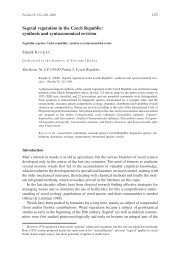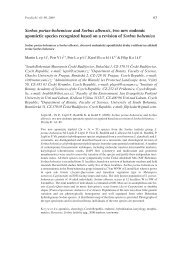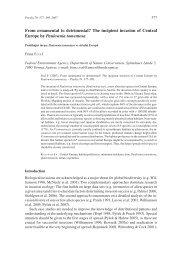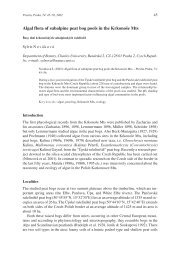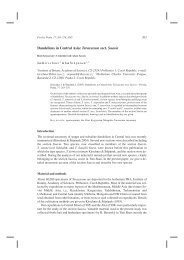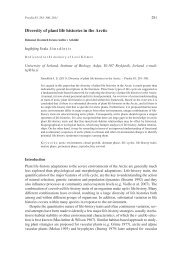Checklist and Red List of lichens of the Czech Republic
Checklist and Red List of lichens of the Czech Republic
Checklist and Red List of lichens of the Czech Republic
You also want an ePaper? Increase the reach of your titles
YUMPU automatically turns print PDFs into web optimized ePapers that Google loves.
154 Preslia 80: 151–182, 2008<br />
<strong>and</strong> a rough estimate <strong>of</strong> <strong>the</strong> proportion <strong>of</strong> categories <strong>of</strong> threat to our lichen flora (Liška<br />
1996). At that time it was estimated that 55% <strong>of</strong> <strong>the</strong> species were threatened. The total<br />
number <strong>of</strong> lichen species was estimated as 1400 (Liška 1996), but due to newly recorded<br />
species is now almost 1500 (Vězda & Liška 1999, Liška 2005 <strong>and</strong> references in Appendix 1).<br />
The IUCN recommended <strong>the</strong> publication <strong>of</strong> a <strong>Red</strong> <strong>List</strong> as a part <strong>of</strong> a revised checklist,<br />
<strong>the</strong>refore <strong>the</strong> complete flora was evaluated <strong>and</strong> a checklist produced.<br />
Application <strong>of</strong> <strong>the</strong> IUCN criteria version 3.1<br />
The compilation <strong>of</strong> this <strong>Red</strong> <strong>List</strong> was complicated <strong>and</strong> time consuming because no preliminary<br />
or local/regional lists existed. We tried to collect new data during field surveys, verify<br />
old localities <strong>and</strong> check specimens in herbaria, but at <strong>the</strong> moment only a part <strong>of</strong> this task<br />
is complete. At present our knowledge <strong>of</strong> <strong>the</strong> lichen flora is poorer than that <strong>of</strong> e.g.,<br />
bryophytes, as illustrated by <strong>the</strong> number <strong>of</strong> newly recorded species (see Palice 1999, Liška<br />
2005, Vondrák et al. 2007 for <strong>lichens</strong>, Soldán 1994, Váňa 1995 for bryophytes). In spite <strong>of</strong><br />
this <strong>and</strong> <strong>the</strong> sometimes poorly founded categorization, it is useful <strong>and</strong> adviseable to compile<br />
a <strong>Red</strong> <strong>List</strong>; arguments based on <strong>the</strong> example <strong>of</strong> bryophytes are discussed by Váňa (1995).<br />
Some general terms used in <strong>the</strong> IUCN categorization raise problems when applied to <strong>lichens</strong>:<br />
(i) Individual: this is difficult to define for cryptogams in general; moreover, <strong>lichens</strong> are<br />
very variable with regard to growth form. Minor problems are encountered when<br />
individualing fruticose or foliose <strong>lichens</strong>. In <strong>the</strong> case <strong>of</strong> <strong>lichens</strong> forming dense carpets or<br />
pendulous fruticose thalli an approximation <strong>of</strong> an individual is a mat or cluster. Most problematic<br />
are crustose thalli forming mosaics, in which individual thalli can grow toge<strong>the</strong>r or<br />
be intermixed.<br />
(ii) Generation: <strong>the</strong>re is a wide range <strong>of</strong> growth rates <strong>and</strong> estimated ages <strong>of</strong> lichen thalli,<br />
Even for <strong>the</strong> same species growth rates may differ by a factor <strong>of</strong> ten or more, depending on<br />
altitude <strong>and</strong> region; annual rates may range from hundreds to tens <strong>of</strong> millimetres.There are<br />
also big differences in life span <strong>and</strong> generative reproduction <strong>of</strong> <strong>lichens</strong>: some live only<br />
a few months (ephemeral <strong>lichens</strong>), o<strong>the</strong>rs for more than a thous<strong>and</strong> years (e.g.,<br />
Rhizocarpon spp.). Moreover, some <strong>lichens</strong> produce nei<strong>the</strong>r fruit-bodies with spores nor<br />
vegetative diaspores. For practical purposes, a generation may be estimated to span approximately<br />
10–30 years.<br />
(iii) Locality: <strong>the</strong> area <strong>of</strong> a locality differs greatly for different lichen species (e.g., hectares<br />
or square kilometers in <strong>the</strong> case <strong>of</strong> some terricolous or saxicolous <strong>lichens</strong> vs. an individual<br />
tree for rare epiphytes).<br />
A compilation <strong>of</strong> a <strong>Red</strong> <strong>List</strong> for a country is difficult because <strong>of</strong> insufficient taxonomic<br />
data on species-rich genera <strong>of</strong> crustose (e.g., Lecanora, Lecidea, Verrucaria) <strong>and</strong> fruticose<br />
<strong>lichens</strong> (e.g., Usnea), <strong>and</strong> <strong>the</strong> chorology <strong>and</strong> ecology <strong>of</strong> many lichen taxa (see e.g., <strong>the</strong> discussion<br />
on criteria <strong>and</strong> parameters in Scheidegger & Goward 2002). This is particularly<br />
<strong>the</strong> case for <strong>the</strong> <strong>Czech</strong> <strong>Republic</strong>, because <strong>the</strong> diversity <strong>of</strong> <strong>the</strong> flora was unknown until <strong>the</strong><br />
publication <strong>of</strong> a Catalogue (Vězda & Liška 1999). This Catalogue provides a list <strong>of</strong> species<br />
reported from <strong>the</strong> <strong>Czech</strong> <strong>Republic</strong>. Although some <strong>of</strong> <strong>the</strong> data were critically evaluated,<br />
many old records are dubious <strong>and</strong> need to be revised. In addition, knowledge <strong>of</strong> <strong>the</strong> present<br />
distribution <strong>of</strong> most <strong>lichens</strong> is still poor. Several corrections <strong>and</strong> additions to <strong>the</strong> Catalogue



